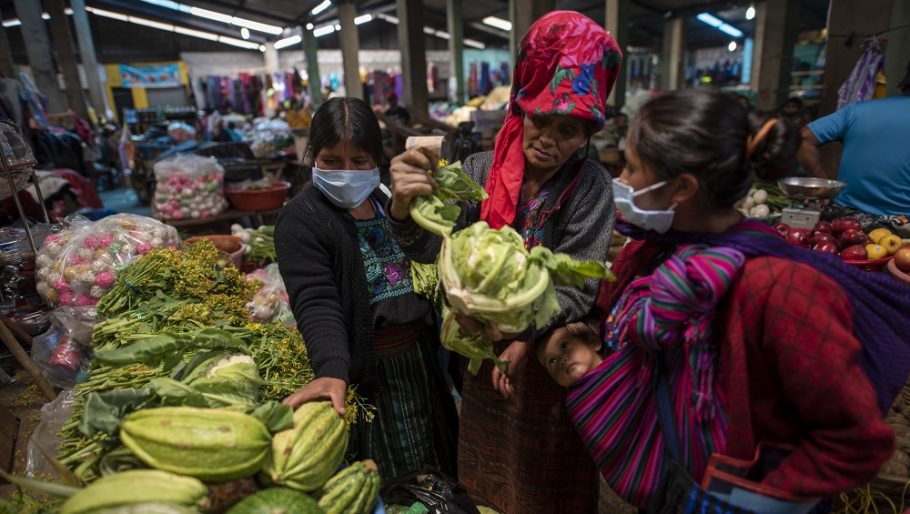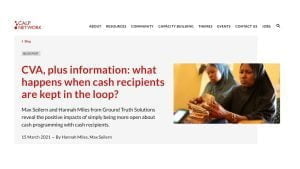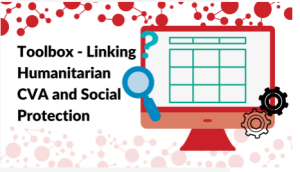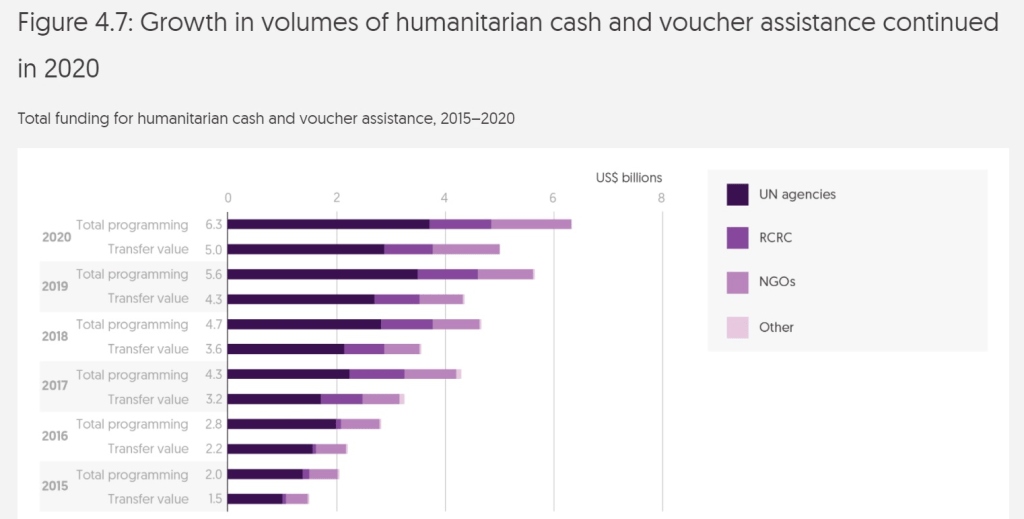Cash and Voucher Assistance in 2021: 6 reflections on progress and pitfalls
CALP’s director Karen Peachey reflects on the state of cash and voucher assistance (CVA) in 2021. Where has there been progress and where is there still a way to go?

With the year coming to an end (for those following the Gregorian calendar) it’s time to reflect on what’s been happening in the world of CVA. Against a backdrop of the climate crisis, the on-going COVID pandemic, increasing humanitarian needs and political upheaval in many parts of the world – it’s easy to only focus on fears and failures. But while progress is slow and uneven in some areas, there is lots of positive news from the land of CVA.
Here are some quick reflections on 6 big themes from 2021.
1. People at the centre – making progress?
The quick answer – patchy.
Undoubtedly, there was progress in some areas. Important initiatives moved forward to advance understanding, thinking and practice on the needs of specific population groups resulting in work on disability inclusive cash assistance, working with adolescents in child protection monitoring and using CVA to support those affected by gender-based violence to mention but a few. This is important progress and learning now needs to be applied widely.

In many responses, however, reports continued to show that recipients felt ill-informed about available assistance, and didn’t understand why some people received support and others didn’t, how long assistance would last and so on. Such information gaps caused stress, confusion and dissatisfaction. This recurring issue highlights the need for more emphasis on charting user experiences, working with recipients to make quality improvements and strengthening communication overall.
It’s not enough that individual agencies are making improvements. In the absence of effective coordination and collaboration at response level, the sum of individual agency decisions – however ‘people centred’ they are – will likely be suboptimal from a user perspective with continuing issues of exclusion, duplication and inconsistencies. Such user experiences underscore why accountability to affected populations needs to be central to decision making and why making progress on cash coordination is so important.
2. Cash coordination: light at the end of the tunnel?
Making progress.
Cash coordination has been a thorny, contested, issue for so long that when there was progress in 2021 it actually came as a bit of a surprise! The turning point was the Call for Action signed by the leaders of 95 organisations and submitted to the Emergency Response Coordinator in June. A leadership level meeting in September further showed how much commitment there is to seeing this issue resolved.
News!! 95 organisations signed up …. To what? About what? Check it out https://t.co/oTaY3vBSzl@calpnetwork@yo__solo @Lynn_CaLP
— Karen Peachey (@KarenPeachey100) June 9, 2021
With momentum gained, a process – under the leadership of the Grand Bargain Eminent Person Jan Egeland – is now underway to agree recommendations to improve cash coordination. Once confirmed, the recommendations will be considered by the IASC and, we may have decisions by mid 2022. So, there may be light at the end of the tunnel on this issue.
Hopefully, in the coming year, the focus will turn to implementing decisions that should then result in more predictable and accountable cash coordination. See CALP’s cash coordination timeline for more details.
3. Localisation – progress or just lip service?
Another mixed picture.
2021 saw a lot of discussion about localisation in all realms of humanitarian work, including CVA. But as the State of the World’s Cash report flagged, while there is a growing consensus on the importance of localisation to the future of CVA this is not matched by any agreement as to what this might mean in practice.
One element on which there is fairly broad agreement is that real progress will require a change in relationships between national and international actors and a shift in power structures within the humanitarian system.
In 2021, the Grand Bargain Cash Workstream came to a close. Happily, the sub-stream on CVA and localisation morphed into the new Cash and Local Partnerships Working Group which, in the second half of the year, started to see an expansion in the number of organisations involved, and important discussions on a wide range of issues. From this forum, the Alliance for Empowering Partnership (A4EP) was elected, by national organisations, to engage in the global cash coordination caucus (see point above).
While various individual initiatives on localisation progressed, tangible progress was slow and the cumulative degree of change was limited or unclear. For example, according to the 2021 Global Humanitarian Assistance Report, all types of humanitarian actors reported an increase in use of CVA but the data couldn’t tell us whether CVA delivery by national actors had increased.
This is because (i) national actors are currently less likely to contribute to international data collection systems and (ii) where national actors work as implementing partners, their role is generally invisible in reporting systems as data is reported by the lead agency. More needs to be done to ensure both visibility and recognition of the work of national actors.
4. CVA, environment and climate change: critical issue or band-wagoning?
Getting started on big issues.
When discussions about CVA, environment and climate change started to gain momentum in 2020 we were challenged by some people who questioned both relevance and motive. However, in 2021, over 100 organisations joined the newly formed CVA, environment and climate change community of practice which is quickly becoming a diverse and dynamic forum; research progressed and plans were developed that will move forward in 2022.
Interest on this level proves that this is a vitally important area of work that needs to be explored and addressed by the entire network. We need to think in terms of (i) how CVA can be used in preparedness, mitigation and response to climate shocks and (ii) understand and take action to reduce the climate and environmental impacts of CVA.
5. Linking humanitarian CVA and social protection: more than talk?
Complex but making progress.

After a drastic expansion of nationally-owned social protection systems in 2020, in response to the impacts of COVID-19 pandemic, discussion of social protection linkages is now firmly embedded in the agenda of humanitarian agencies. The last year has seen a growth in more nuanced reflections based on practical experiences and the generation of valuable guidance. Increasingly, we are recognising that, whatever the context, there are steps that can be taken by humanitarians to support developing social protection systems particularly in terms of coordination (between humanitarian and development actors and government) and in providing technical accompaniment.
Perhaps effective linkages between humanitarian CVA and other forms of financial assistance (including social protection) will finally provide the bridge between humanitarian and development action that has been elusive for so long.
6. Increased use of CVA: how much further to go?
A long way!
The use of CVA continued to increase both in volume and as a percentage of overall aid. Figures published in 2021 show that US6.3bn was spent on CVA in 2020 accounting for 19% of international humanitarian assistance – up 13% on the previous year.

These figures are just part of the picture, as they list only CVA reported as part of international humanitarian assistance and do not include the huge volumes of national government transfers (humanitarian and social protection) or other forms of financial assistance.
While data is not yet available, it seems likely that the use of CVA has increased further as a proportion of aid in 2021.
So how much further can it increase? While the analysis is a few years old, GPPI estimated that if CVA was the default modality in all humanitarian responses (i.e. used everywhere where feasible and appropriate) it would account for c. 37% to 42% of all humanitarian assistance. So much as the use of cash continues to increase – clearly it still has a long way to go,
There were, of course, many other big themes in 2021 – with great progress on thinking about CVA and health outcomes; the heightened profile of responsible data management; exploration of CVA in contexts of high inflation and depreciation; more focus on financial service providers and much, much, more.
So what of next year, what will be the big themes and priorities?
Many of the issues mentioned above will continue to be a focus for action in 2022 with some moving even further into the spotlight. The end of the Grand Bargain Cash Workstream does raise questions about collective priorities going forward. As the Call for Action on cash coordination and new Communities of Practice have shown, when we work together, we can make more progress. The question is, what are the priorities that every organisation, big or small, now need to get behind to ensure better assistance for people in crisis? This is a question we will be exploring next year.
Main image – San Mateo Ixtatán, located in the department of Huehuetenango, Guatemala, is 2,540 metres above sea level, amid the Sierra de los Cuchumatanes. Being able to buy fresh food for their families is a relief for the women. Photo: WFP/Carlos Alonzo.


